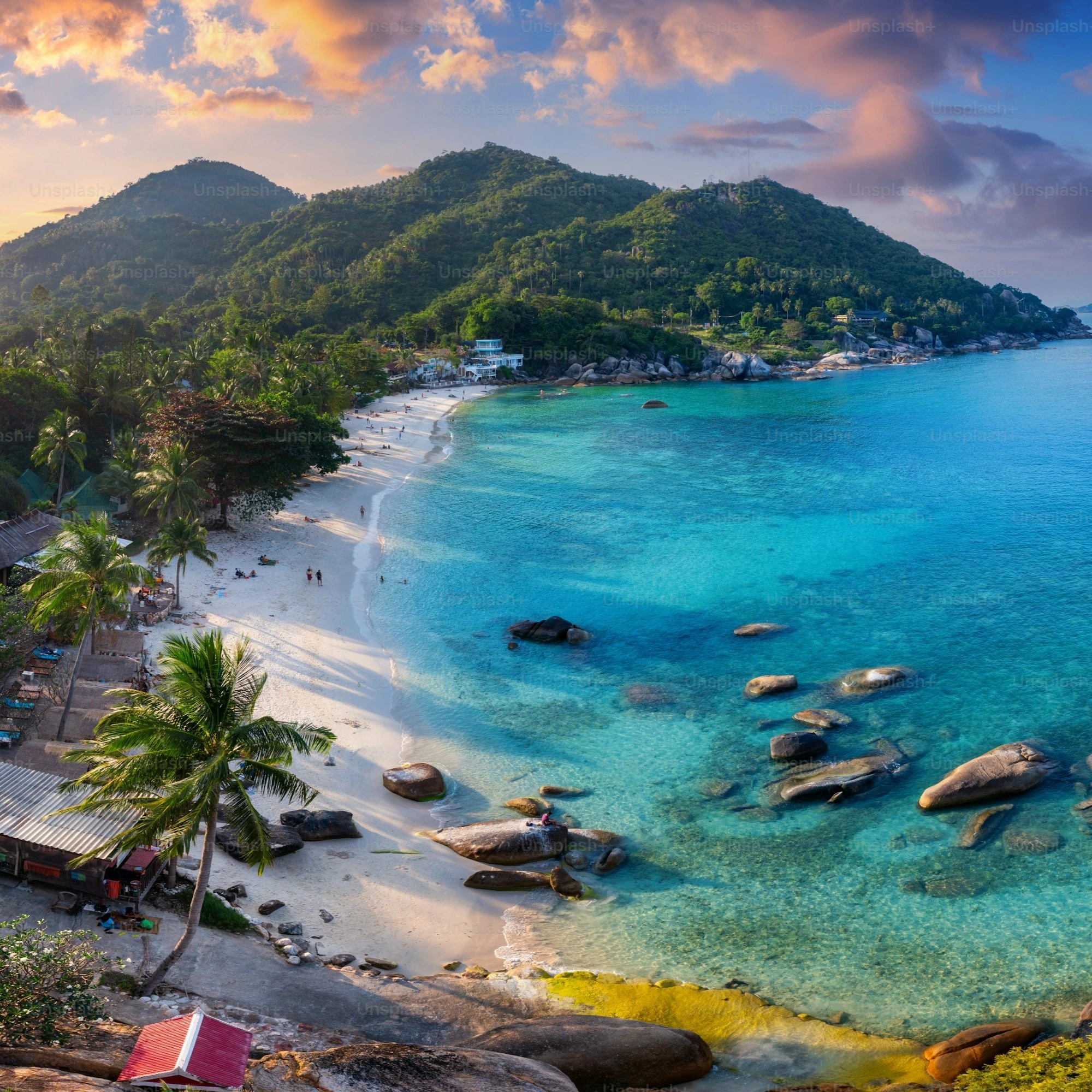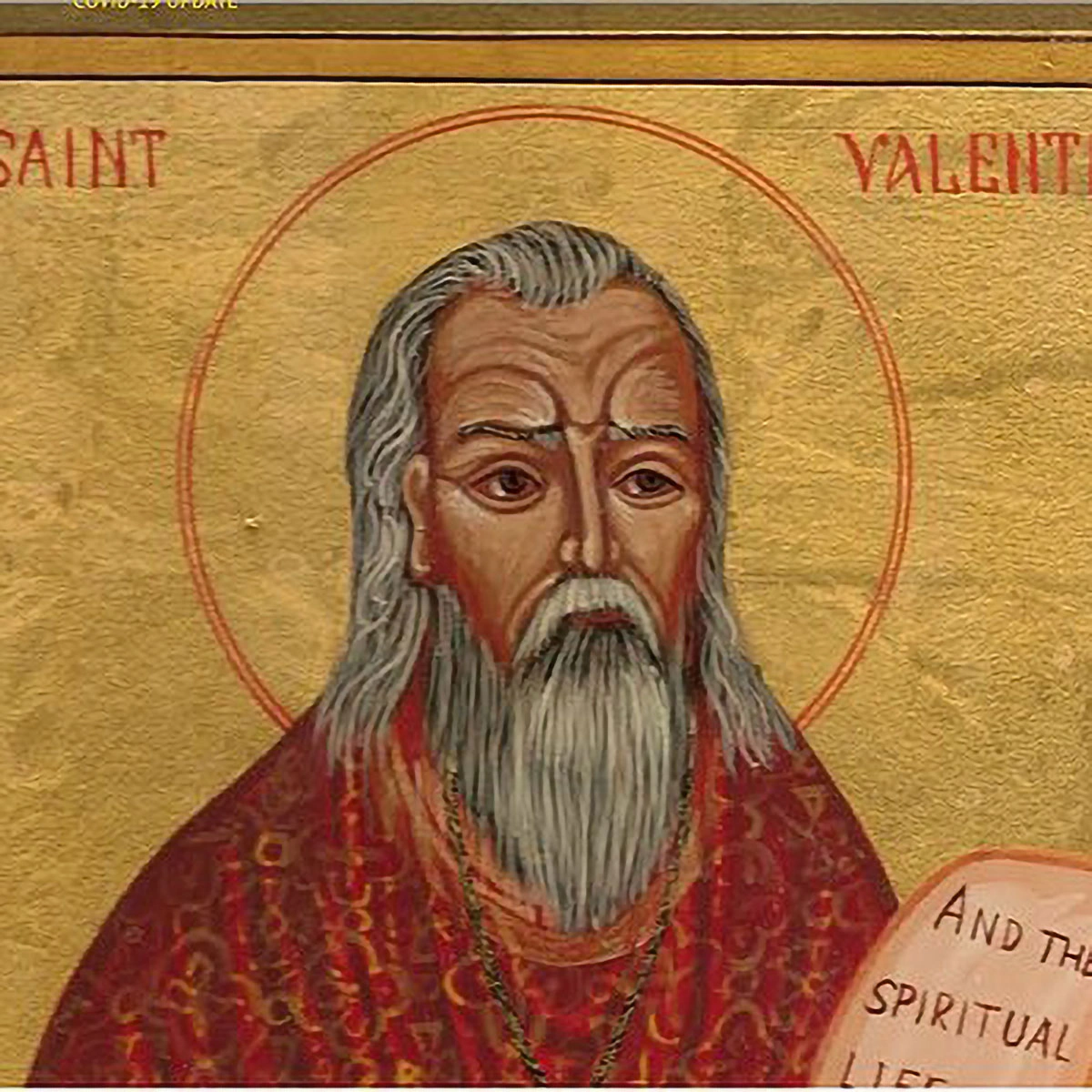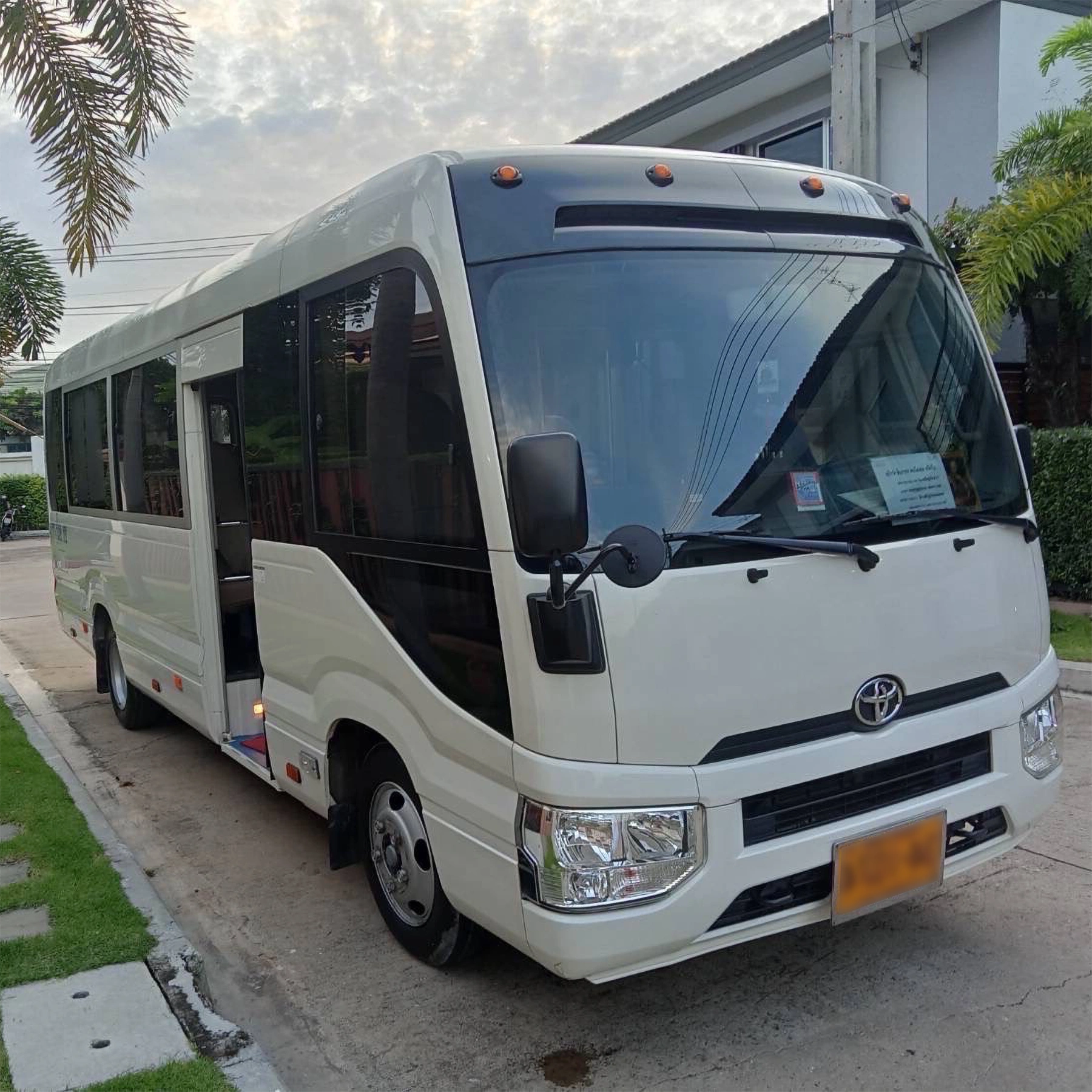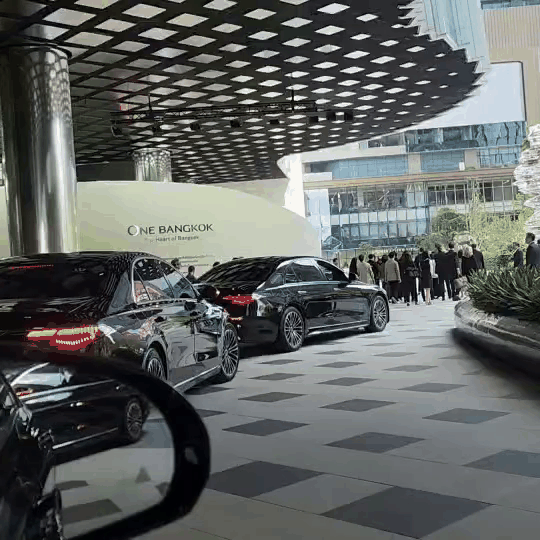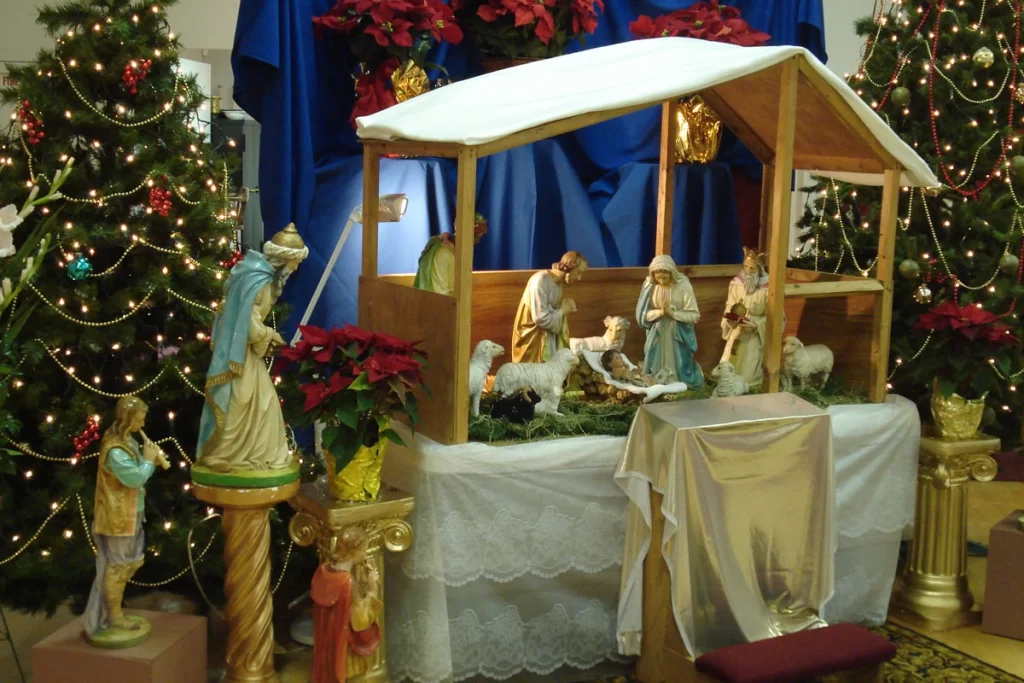
1. Christmas Festivals
Christmas is celebrated worldwide in various forms, but if you want to experience a truly magical atmosphere, the Christmas markets in Europe are the places to visit. Cities in Germany, Austria, and France are adorned with twinkling lights from Christmas trees and landmarks, creating an enchanting atmosphere. You can also shop for handmade gifts and traditional treats at the markets. Every evening, Christmas carols and festive activities bring the spirit of the season to life, making you feel like you’re walking in a winter wonderland.
However, Christmas is not just a time for social celebration and entertainment—it holds deep religious significance for Christians around the world. It marks the birth of Jesus Christ, a moment of profound importance in Christian faith. Attending church services, particularly the Christmas Eve Mass, is a key part of the holiday in many countries. These services often include scripture readings, carol singing, and moments of reflection on the love and hope that God brought to the world through the birth of Jesus.
The religious observances of Christmas typically include Midnight Mass and other sacred rituals, where people gather to celebrate the coming of Christ. These moments are a reminder of the teachings of Jesus and the message of peace, love, and salvation that he brought to humanity.
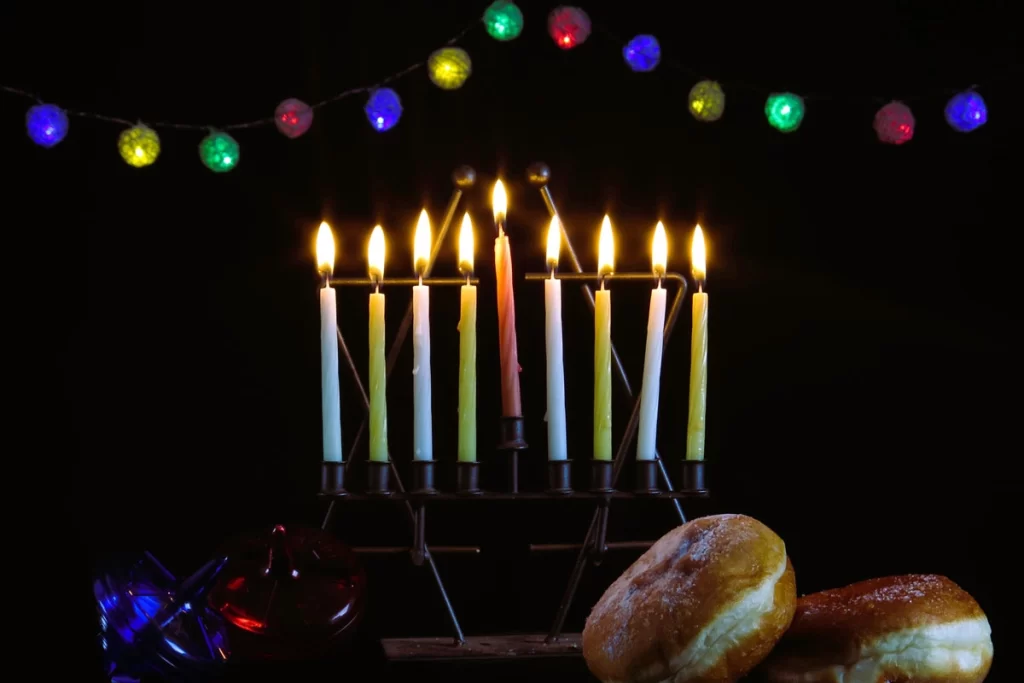
2. Hanukkah
Hanukkah, also known as the Festival of Lights, is a significant Jewish holiday celebrated annually for eight days. It begins on the 25th of the month of Kislev in the Jewish calendar, typically falling in December. Hanukkah commemorates a historic event when the Jewish people reclaimed the Holy Temple in Jerusalem and purified it after it had been defiled during occupation.
The main ritual of Hanukkah involves lighting the Menorah or Hanukkiah, a nine-branched candelabrum. Each night of the festival, an additional candle is lit until all eight candles are burning on the final night. The ninth candle, called the Shamash, is used to light the others. This lighting ritual symbolizes the miracle that took place when a small amount of oil, enough to last for only one day, miraculously kept the temple’s menorah lit for eight days.
Traditions and Activities:
Hanukkah is a time for family and community gatherings, and traditional foods fried in oil are enjoyed to honor the miracle of the oil. These foods include latkes (potato pancakes) and sufganiyot (jelly-filled donuts). Families and friends also engage in games, particularly with the dreidel, a four-sided spinning top inscribed with Hebrew letters. These letters stand for the phrase “A great miracle happened there,” reminding participants of the miracles associated with the festival.
Hanukkah carries deep meaning, representing resilience, faith, and the importance of religious freedom. It’s not only about lighting candles but also about remembering the values of justice, strength, and the enduring hope that helped the Jewish people protect their beliefs and traditions.
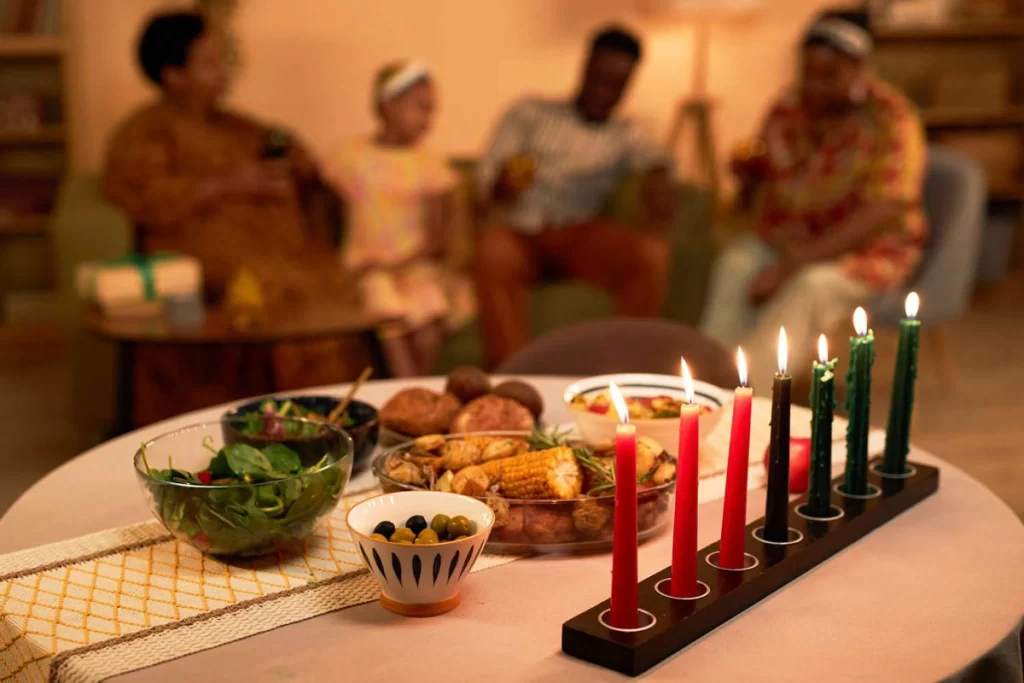
3. Kwanzaa
Kwanzaa is a cultural celebration that honors African-American heritage, unity, and cultural pride. This week-long festival begins on December 26 and continues through January 1. Established in 1966 by Dr. Maulana Karenga, Kwanzaa was created as a way for African-Americans to reconnect with their African roots and celebrate their shared values, traditions, and achievements.
The celebration of Kwanzaa is centered around seven core principles, known as the Nguzo Saba, which represent fundamental values of African culture. These principles are:
Umoja (Unity): To strive for and maintain unity in the family, community, nation, and race.
Kujichagulia (Self-Determination): To define and speak for oneself.
Ujima (Collective Work and Responsibility): To build and maintain the community together and help solve each other’s problems.
Ujamaa (Cooperative Economics): To support and sustain businesses within the community.
Nia (Purpose): To develop a sense of purpose and contribute to the betterment of the community.
Kuumba (Creativity): To do everything as creatively as possible to improve the community.
Imani (Faith): To believe in people, parents, teachers, and leaders, and in the righteousness and victory of the struggle.
Each day of Kwanzaa, one of these principles is celebrated and reflected upon. The symbol of the festival is the Kinara, a seven-branched candle holder. During the celebration, a candle on the Kinara is lit each night, representing one of the seven principles. The candles are arranged with three red candles on the left, three green candles on the right, and a black candle in the center. The black candle is lit first, representing unity, followed by alternating red and green candles throughout the week.
Cultural Traditions and Celebrations:
Kwanzaa gatherings often include storytelling, African drumming, singing, dancing, and reading poetry. Families and communities come together to share meals, exchange handmade gifts, and participate in discussions that emphasize the importance of unity, self-awareness, and mutual support. The festival culminates in a feast called Karamu, held on December 31, where traditional African and African-American dishes are served, and participants express gratitude for their heritage and reflect on their achievements.
Kwanzaa is not a religious holiday but a cultural celebration that promotes African heritage and a sense of community. It is a time to honor ancestors, strengthen bonds, and foster a sense of pride and identity. Through the principles of Kwanzaa, participants are encouraged to embrace and reflect on values that uplift and empower their families, neighborhoods, and communities.
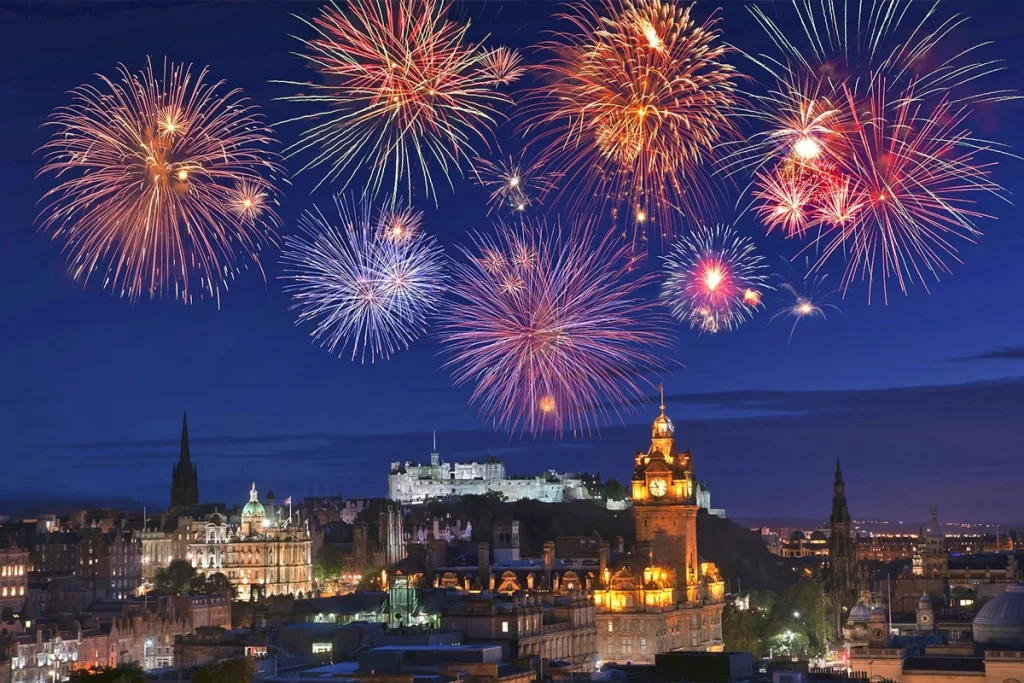
4. Hogmanay
Hogmanay is Scotland’s most famous and grand New Year celebration, held on Tuesday, December 31, 2024, and often continuing through January 1 or 2 in some areas. This event attracts people from around the world who come to experience the lively atmosphere, especially in Edinburgh, where one of the largest Hogmanay celebrations takes place.
Main Activities of Hogmanay:
Countdown and Fireworks:
The Edinburgh celebration begins with the impressive Torchlight Procession, where thousands of people carry torches through beautifully decorated streets. When it’s time to countdown to the New Year, the sky above Edinburgh Castle lights up with a stunning fireworks display, filling the air with joy, hope, and excitement.Concerts and Live Music:
The festivities also include live performances from popular bands and artists, as well as traditional Scottish ceilidh dancing, where visitors can engage in local culture and dance together.First Footing Tradition:
One of the most cherished traditions of Hogmanay is First Footing. It is believed that the first person to enter a home after midnight brings good luck for the coming year. This “first footer” often brings small gifts like coal, bread, or whisky, symbolizing warmth and prosperity.Loony Dook:
On New Year’s Day, many brave participants join in the Loony Dook, a fun event where people plunge into the icy waters of rivers or the sea to start the year with a refreshing dip.
Cultural Significance:
Hogmanay is more than just a typical New Year celebration—it reflects the longstanding traditions and cultural heritage of Scotland. Community warmth and welcoming strangers are at the heart of this festival. Additionally, the singing of Auld Lang Syne, a traditional song written by the Scottish poet Robert Burns, is an essential part of the celebration. The song serves as a reminder of friendship and memories from the past year.
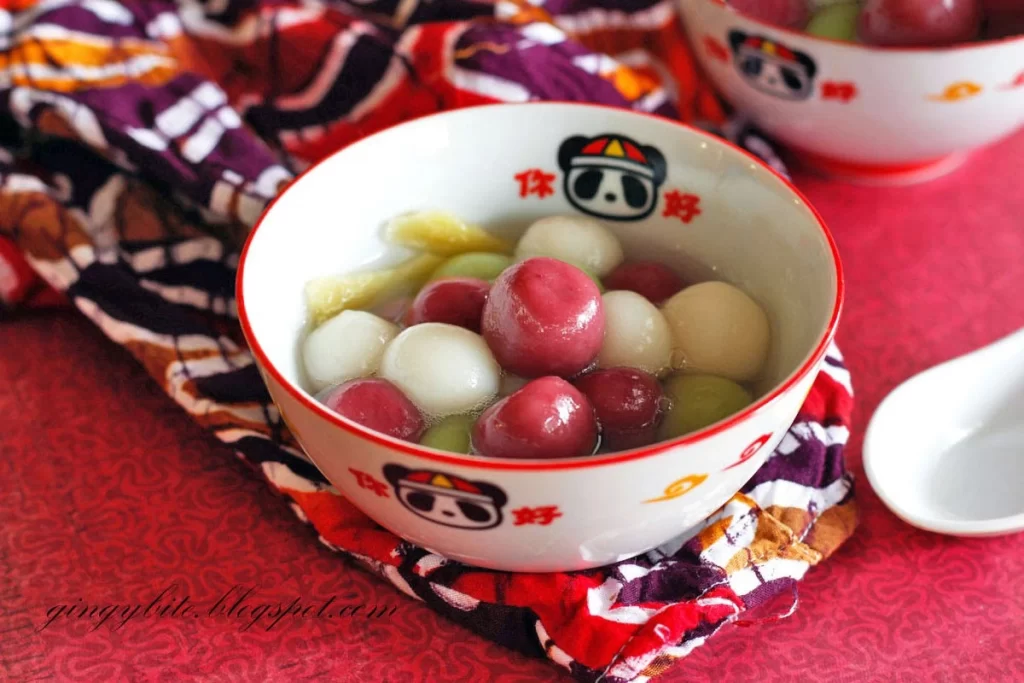
5. Dongzhi Festival
The Dongzhi Festival, also known as the Winter Solstice Festival, is one of the most important traditional festivals in Chinese culture, celebrated on December 21 or December 22, when the Northern Hemisphere experiences the shortest day and longest night of the year. Rooted in ancient Chinese philosophy and astrology, Dongzhi signifies the “arrival of winter” and marks the balance point of Yin and Yang, symbolizing a turning point toward longer days and increasing light.
Family Reunion and Traditional Foods
Dongzhi is primarily celebrated as a time for family reunions, with loved ones gathering to share meals and enjoy each other’s company. A popular food associated with Dongzhi is Tangyuan, which are sweet glutinous rice balls often filled with black sesame, red bean, or peanut paste. Tangyuan, whose round shape symbolizes unity and completeness, is typically served in a warm, sweet soup, making it a comforting treat during the cold winter days. Eating Tangyuan together is believed to bring warmth, harmony, and good fortune to the family.
In northern China, families also prepare and eat dumplings during Dongzhi. According to tradition, eating dumplings on the Winter Solstice can help keep one’s ears from getting frostbitten, a belief stemming from an ancient Chinese folktale. Each family often has its own recipe, and making dumplings together has become a cherished activity that strengthens family bonds.
Cultural and Philosophical Significance
Beyond being a family celebration, Dongzhi holds deep cultural significance, as it is tied to the concept of Yin and Yang. According to traditional beliefs, the extreme Yin (cold and darkness) of the Winter Solstice will gradually give way to Yang (warmth and light), symbolizing hope, renewal, and the promise of a new beginning. This philosophy emphasizes balance and harmony, core values in Chinese culture.
Traditional Customs and Observances
In addition to feasting, many families pay respects to their ancestors during Dongzhi, offering prayers and symbolic foods at family altars to honor and remember their forebears. Some communities also host temple ceremonies and folk performances, celebrating the festival with lively gatherings that express gratitude for the year that has passed and hope for the year to come.
For many, Dongzhi serves as a reminder to pause, connect with loved ones, and find warmth in togetherness amidst the coldest time of the year. It reinforces family values and a sense of cultural identity, bringing people closer as they welcome the gradual return of light.
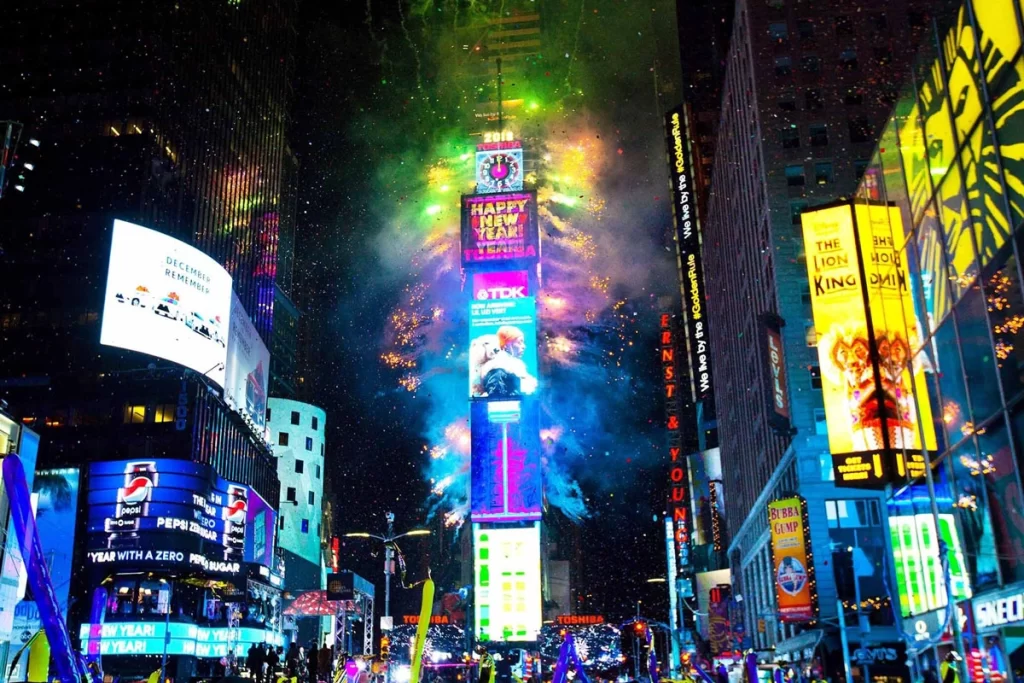
6. New Year’s Eve in Times Square
The New Year’s Eve celebration in Times Square, New York City, is one of the most iconic and widely recognized New Year events in the world. Every year on December 31, millions of people from all over the world gather in the heart of Manhattan to witness the grand countdown and the famous Ball Drop, a tradition that dates back to 1907. The anticipation builds as the clock ticks closer to midnight, with everyone counting down from 10 to 1 as the ball makes its descent from the top of One Times Square.
The Ball Drop:
The Times Square Ball Drop is the highlight of the evening. The iconic crystal ball, adorned with over 2,000 Waterford crystals and LED lights, begins its 60-second descent at exactly 11:59 p.m. The crowd erupts in cheers and celebration as the ball completes its journey, symbolizing the arrival of the New Year. This tradition has become a global phenomenon, with people watching the live broadcast of the event from around the world.
Live Performances and Entertainment:
Throughout the evening, the atmosphere is filled with excitement, as live performances from renowned artists and bands entertain the crowd. Major celebrities and musicians take the stage, adding energy and glamour to the celebration. The lineup of entertainers often includes a mix of genres, appealing to a wide range of audiences and creating an unforgettable experience for all in attendance.
Fireworks and Confetti Explosion:
As the clock strikes midnight, a spectacular display of fireworks illuminates the sky, and an explosion of colorful confetti rains down upon Times Square, covering the crowd in a sea of colors. The confetti, which includes messages of hope written by people from all over the world, adds a personal and emotional touch to the celebration.
Security and Crowd Management:
Given the massive number of attendees, New York City takes extensive security measures to ensure the safety of everyone in Times Square. Streets are closed off, and spectators go through security checkpoints. Many people arrive hours early, braving the cold and standing in tightly packed crowds to secure a good spot for viewing.
A Global Celebration of Hope and Renewal:
New Year’s Eve in Times Square is more than just a local event; it’s a global symbol of hope, renewal, and unity. People from different cultures and backgrounds come together to celebrate the beginning of a new year, filled with new possibilities. As the ball drops and the confetti falls, there’s a collective feeling of optimism and excitement for the future.
Tips for Attending:
For those planning to attend in person, it’s recommended to arrive early in the day to secure a viewing spot, dress warmly, and bring snacks, as re-entry is not allowed once you enter the viewing area. Times Square can be crowded and cold, but for many, the experience of counting down with thousands of others and witnessing the ball drop in person is a once-in-a-lifetime memory.
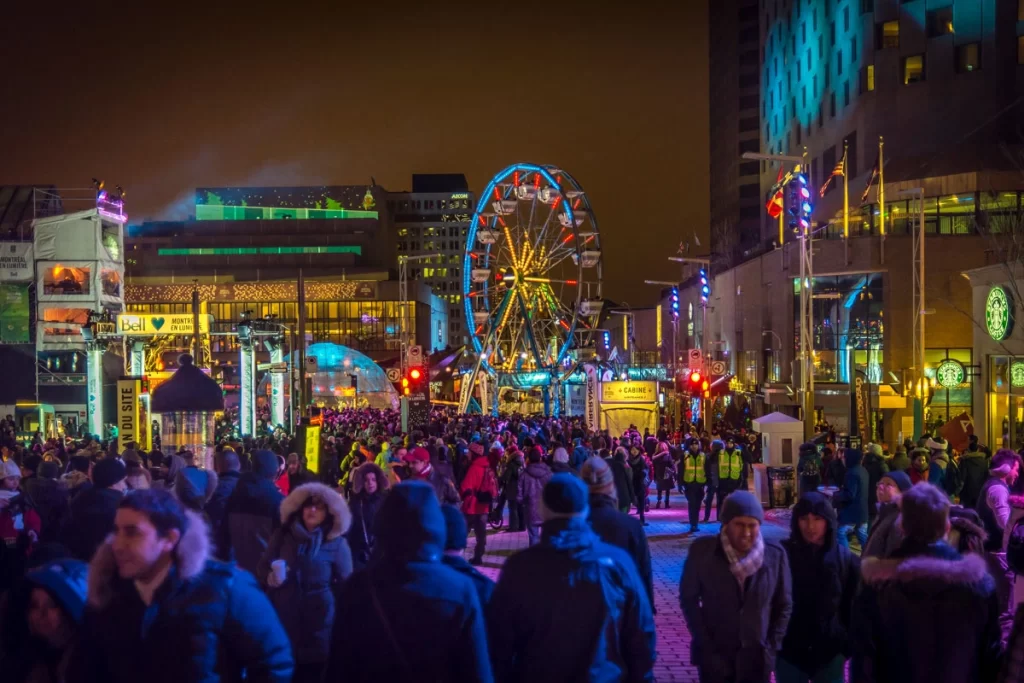
7. Montreal en Lumière
Montreal en Lumière, also known as the Montreal Festival of Lights, is one of Canada’s largest winter festivals, held in late February in the city of Montreal. This festival is renowned for its breathtaking light displays that transform the city into a winter wonderland, lighting up the cold, dark winter nights and creating an atmosphere of warmth and magic.
Highlights of Montreal en Lumière:
Outdoor Light Displays and Illuminations:
The light installations are the heart of Montreal en Lumière, with vibrant and interactive light art displayed throughout the city. Structures and landmarks are adorned with colorful lights, and installations invite viewers to engage and experience the beauty of the lights firsthand. The Quartier des Spectacles, Montreal’s entertainment district, is especially transformed with stunning light and color displays during the festival, creating a surreal and enchanting experience.Art Exhibitions and Live Music Performances:
Montreal en Lumière also features a variety of art forms, including live music performances, dance shows, and special exhibitions curated for the festival. Local and international artists take the stage at different venues across the city, offering a rich and diverse cultural experience for festival-goers. It’s an opportunity to celebrate both the local art scene and global talent.Gastronomy and Wine Events:
One of the festival’s main attractions is its focus on food. Renowned chefs from Canada and around the world come together to showcase unique and creative dishes for the festival. Restaurants throughout Montreal offer special menus, and wine-tasting events allow visitors to savor the city’s culinary excellence. There’s also a nighttime food market, where people can sample local specialties and purchase artisanal goods from regional producers.Outdoor Activities and Fun Zones:
The festival also includes a variety of outdoor activities perfect for families and those who enjoy winter fun. These include an ice-skating rink with special lighting effects, ice slides, and other engaging activities that allow participants to fully embrace the winter season in a festive and exciting way.Nuit Blanche (White Night):
One of the most anticipated events of the festival is Nuit Blanche or “White Night,” when the city stays open all night for people to explore and participate in activities. Art installations, performances, and cultural experiences are spread throughout Montreal, with museums, galleries, and cultural centers offering free admission and special events. Nuit Blanche turns the entire city into a vibrant celebration of art and community, lasting until dawn.
A Unique Winter Experience:
Montreal en Lumière brings life and warmth to Montreal’s winter season. It’s more than just a festival of lights; it’s a celebration of art, food, and local culture, making it an event suitable for all ages. Whether you’re a family, a couple, or a group of friends, Montreal en Lumière offers a unique and unforgettable experience amid the beauty and cold of winter.
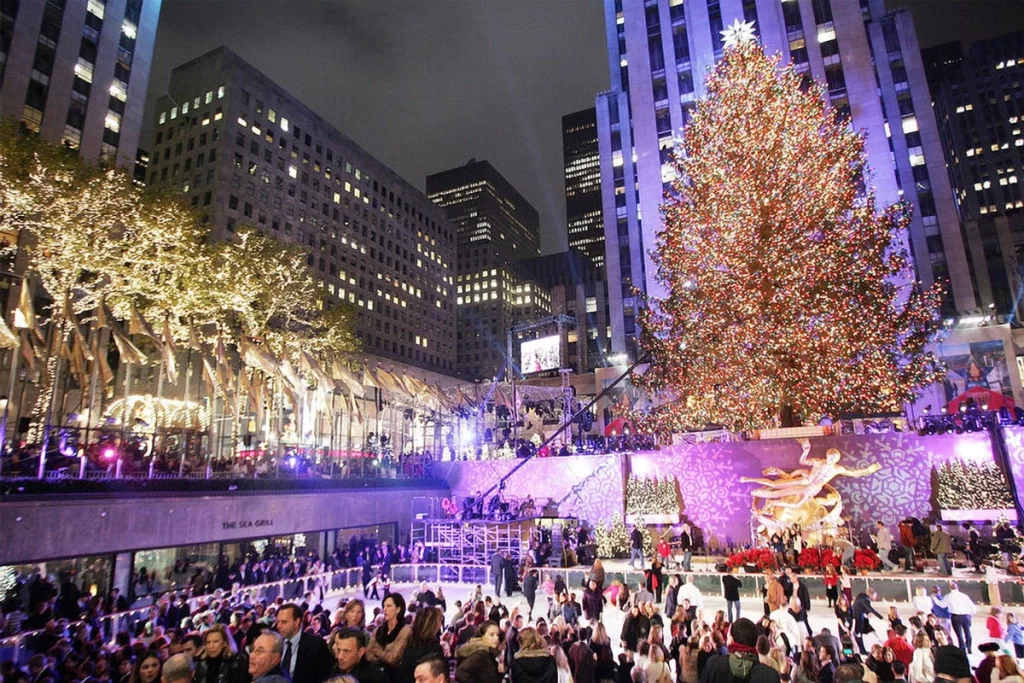
8. Rockefeller Center Christmas Tree Lighting
The Rockefeller Center Christmas Tree Lighting in New York City is one of the most iconic and celebrated Christmas events in the United States. The tree, usually a massive Norway spruce, stands between 70 and 100 feet tall and is carefully chosen from various locations across the country to ensure it has the perfect shape and size for this grand event.
The Lighting Ceremony and Atmosphere
The tree lighting ceremony typically takes place in late November or early December. The tree is adorned with tens of thousands of LED lights that illuminate it from top to bottom, and at its peak sits a large Swarovski star, made with thousands of crystals, which adds a spectacular focal point to the display. The lighting of the tree transforms Rockefeller Center into a magical sight, drawing crowds of visitors from all around the world.
Live Music and Performances
Following the lighting ceremony, live performances by popular artists and well-known singers fill the air with festive cheer. The event often includes performances by the Rockettes, a dance troupe that has become synonymous with Christmas in New York. These performances create a warm, inviting atmosphere and enhance the holiday spirit for all in attendance.
The Ice Skating Rink
At the base of the Christmas tree lies the famous Rockefeller ice skating rink, a beloved attraction for both New Yorkers and tourists. Skating in this iconic location, surrounded by towering skyscrapers and the beautifully lit Christmas tree, offers a unique holiday experience, especially during the Christmas season.
Cultural Significance
The Rockefeller Center tree lighting tradition began in 1933 and has since become an essential part of New York City’s holiday celebrations. More than just a Christmas celebration, the tree lighting symbolizes unity and hope during the year’s end. People from around the globe gather to witness this special event, and those unable to attend in person can watch the live broadcast, which reaches audiences worldwide.
Tips for Visitors
If you’re planning to attend the Rockefeller Center Christmas Tree Lighting, it’s best to arrive early to secure a good viewing spot, as the area can get very crowded. Be prepared for chilly weather, and consider exploring the surrounding areas, which are also decorated with beautiful lights during the holiday season.
Embracing the Festive Spirit
The Rockefeller Center Christmas Tree Lighting is a highlight of New York City’s holiday season. It’s a time when people from all walks of life come together to celebrate and enjoy the warmth and joy of the season, making it a truly magical experience to witness at the end of the year.
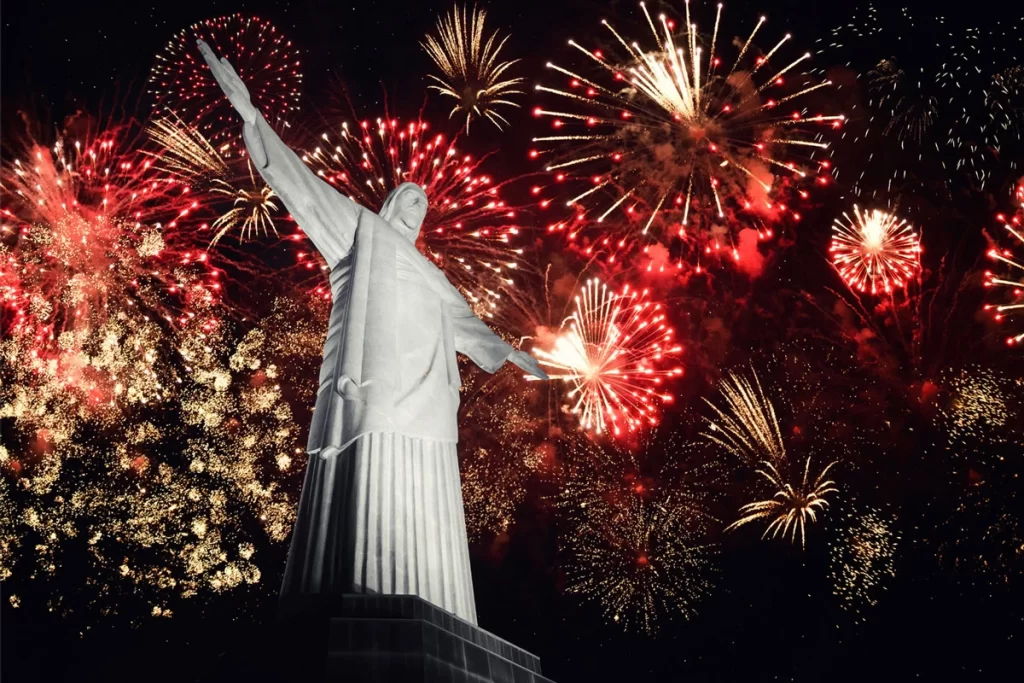
9. Reveillon in Rio
Reveillon is one of Brazil’s largest and most iconic New Year’s Eve celebrations, held annually on Copacabana Beach in Rio de Janeiro. Known worldwide for its vibrant atmosphere and spectacular fireworks, this celebration attracts millions of people from around the globe who come to experience the thrill and joy of welcoming the New Year on one of the world’s most famous beaches.
Atmosphere and Dress Code
Participants at Reveillon typically dress in white, a color symbolizing peace and renewal in Brazilian culture. Wearing white is believed to bring good luck for the New Year. Many attendees also bring flowers to offer to Yemanjá, the Afro-Brazilian goddess of the sea, as a way to honor her and seek blessings for the year ahead. This tradition reflects the deep cultural blend of African and Brazilian beliefs.
Spectacular Fireworks Display
One of the main highlights of Reveillon is the breathtaking fireworks display, which lasts for over 15 minutes. The sky above the Atlantic Ocean lights up with dazzling fireworks synchronized to music, creating a mesmerizing visual and auditory experience. This grand display is a sight to behold and is one of the most memorable parts of the celebration, leaving a lasting impression on everyone in attendance.
Live Music and Dancing
Copacabana Beach transforms into a giant concert venue, with multiple stages set up along the shore featuring live music by renowned Brazilian and international artists. The music ranges from samba and bossa nova to pop and electronic, inviting everyone to dance on the sand and enjoy the night until the early hours of the morning. The lively music and dance create an electric atmosphere that embodies the joyful spirit of Rio.
Rituals and Cultural Beliefs
In addition to the general celebrations, many attendees participate in rituals to honor Yemanjá, the goddess of the sea. It’s a common tradition to throw flowers or small offerings into the ocean as a gesture of gratitude and a request for protection and blessings in the New Year. This ritual, influenced by Afro-Brazilian and Catholic beliefs, highlights the connection between people and nature, as well as the cultural diversity of Brazil.
A Family and Community Celebration
Reveillon is a celebration that brings together families, friends, and communities. People of all ages gather on the beach to enjoy the festivities, making it a time of unity and togetherness. It’s not only a celebration for individuals but a communal event that reflects the harmony and solidarity of Brazilian society.
Tips for Attendees
If you’re planning to attend Reveillon at Copacabana Beach, it’s recommended to arrive in the afternoon to secure a good viewing spot, as the beach will become increasingly crowded. Dressing in white is encouraged to follow tradition, and bringing snacks and drinks for a picnic can enhance the experience, allowing you to relax and fully enjoy the night.
An Unforgettable Experience
Reveillon in Rio is more than just a New Year’s celebration; it’s a display of joy, peace, and a hopeful start to the year. People from all over the world come together to bid farewell to the old year and welcome the new one in an atmosphere filled with beauty, warmth, and cultural richness. It’s a truly unforgettable experience, leaving a lasting impression on everyone who takes part.
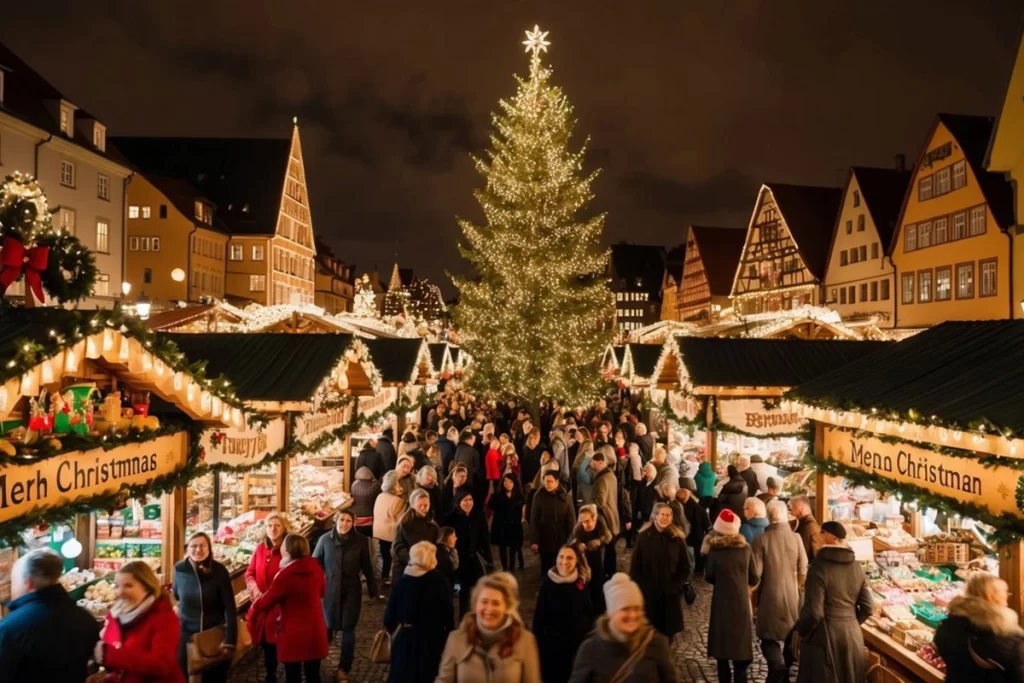
Chicago Christmas Tree Lighting and Holiday Markets
The Chicago Christmas Tree Lighting at Millennium Park is one of the city’s most iconic holiday events. Each year, a massive Christmas tree is carefully chosen and decorated with thousands of twinkling lights and beautiful ornaments. The tree lighting ceremony, typically held in late November, brings together crowds of Chicagoans and visitors to witness the official kickoff of the holiday season.
The Tree Lighting Ceremony
On the evening of the tree lighting at Millennium Park, the atmosphere is filled with warmth and excitement as the tree lights up in a dazzling display. Attendees gather to enjoy this stunning symbol of the holiday season, while live performances by local bands and choirs add to the festive cheer. The ceremony is a heartwarming experience, as people come together to celebrate the joy and beauty of the Christmas season.
Holiday Markets
At the same time, Chicago hosts several holiday markets, the most famous being the Christkindlmarket at Daley Plaza. Inspired by traditional German Christmas markets, this market offers a wide selection of handmade gifts, artisanal crafts, ornaments, and holiday decor. Visitors can also enjoy German-inspired food and drinks, such as bratwurst, pretzels, and warm mulled wine. The Christkindlmarket provides a charming European atmosphere and has become a beloved tradition for locals and tourists alike.
Family-Friendly Events and Performances
Throughout December, Chicago is filled with various family-friendly events and performances, including live music from local musicians, Christmas plays, and other festive shows held at different venues across the city. Some events take place outdoors at Millennium Park, while others are held in galleries and museums, allowing people to experience the unique holiday spirit of a bustling city.
Ice Skating at Millennium Park
One of the must-do activities is ice skating at the McCormick Tribune Ice Rink in Millennium Park. Open throughout the winter season, this ice rink attracts both locals and visitors. Skating amid the festive lights and vibrant city backdrop offers a magical holiday experience, creating cherished memories for people of all ages.
A Complete Christmas Experience in Chicago
Chicago’s Christmas celebrations offer more than just beautiful lights and holiday markets; they bring together families and communities in a festive end-of-year gathering. Visitors and residents alike can feel the love, joy, and togetherness through various activities and lively holiday scenes across the city. The season brings warmth and excitement to Chicago, making it a perfect place to experience the magic of Christmas.
Each of these celebrations offers a unique way to experience the magic of December, from winter markets to grand New Year festivities. These events not only celebrate the season but also showcase the rich cultural diversity around the world, making December a truly special month for travel and celebration.
THAITAXISERVICES™ Tweet
